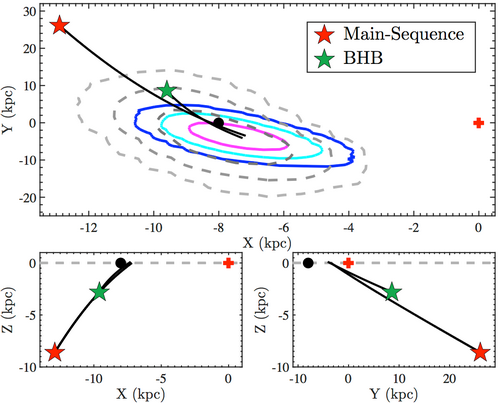Astronomers from National Astronomical Observatories of Chinese Academy of Sciences (NAOC), Dr. Yinbi Li, Prof. Ali Luo, Prof. Gang Zhao, Prof. Youjun Lu, and their collaborators discovered a new B-type hyper-velocity star (LAMOST-HVS4) from LAMOST DR6, and its Galactocentric radial velocity is about 585 km s-1, which makes it the fastest hyper-velocity star discovered from LAMOST so far. This work has been accepted by Journal of the Astronomical Journal (AJ, 2018, 156, 87L).
Hyper-velocity stars are rare in the Galaxy and are moving so fast that they may escape from the Galaxy. Several dynamical mechanisms can produce hyper-velocity stars, including dynamic interactions between the massive black hole(s) in the Galactic center and stars, multi-body dynamic interactions of the young stellar clusters or supernova explosions of the binaries in the Galactic disk, or the tidal interactions between the Galaxy and its dwarf galaxies.
Dr. Yinbi Li and her coauthors found this hyper-velocity star from the first quarter data of LAMOST DR6 (the spectrum is shown in Figure 1). It is probably a B6 type main sequence star, and the possibility of a BHB star is not excluded completely only with its atmospheric parameters. Thus, the research team calculated the absolute magnitudes, photometric distances (no reliable parallax is provided by GAIA DR2 for this star), ages, space positions and velocities for the two issues respectively. The calculation results show that LAMOST-HVS4 is 30 kpc away from the Galactic center (BHB:13kpc), and is leaving the Galaxy with a velocity of 586 km s-1(BHB: 590 km s-1). Adopting five Galactic potential models, the research team also found that whether LAMOST-HVS4 is a main sequence star or a BHB star, it could escape from the Milky Way under the five potential models.
In order to investigate its possible origin, the research team calculated its trajectory with the radial velocity from LAMOST and proper motions from GAIA DR2, and it was likely produced from the multi-body dynamic interactions of the young stellar clusters or supernova explosions in binaries at the Galactic disk. In addition, the research team also found that LAMOST-HVS4 was ejected almost in the Galactic rotation direction, and about 1% hyper-velocity stars are such stars. So, LAMOST-HVS4 is the first hyper-runaway star (stars produced from the Galactic disk and have high velocities) discovered from LAMSOT, and this is also the first time to report such rare hyper-runaway star ejected in the rotation direction of the Galactic disk.
Link to the paper:
http://adsabs.harvard.edu/abs/2018AJ....156...87L

Figure 1. LAMOST spectrum of LAMOST-HVS4. The inset shows the enlarged normalized spectrum from 3850 to 4600 ? for a better view of the spectral lines.

Figure 2. Galactocentric radial velocities of known HVSs and LAMOST-HVS4 vs. the Galactocentric distances. The five short-dashed curves are escape velocities determined from the five Galacticpotential models, and the difference illustrates the current uncertainties between these models. There are two larger red filled pentagrams, which represent LAMOST-HVS4 as a B-type MS star or a BHB respectively. The three smaller red filled pentagrams are the other three LAMOST HVSs, and other black filled pentagrams represent 23 identified B-type HVSs.

Figure 3. Two-dimensional projections of the orbit of LAMOST-HVS4 under the Kenyon+2014 potential model in the Galactic rectangular coordinates. Symbols mark the present positions of LAMOST-HVS4 (red and green pentagram), the GC (red filled plus), and the Sun (black filled circle). The color contours mark the 1σ,2σ, and 3σ confidence levels of intersection points between the trajectories and the Galactic disk if it is an MS star, and the gray dashed contours show intersection regions if it is a BHB star.

Address: 20A Datun Road, Chaoyang District, Beijing, China code: 100012
Tel: 010-64888708 E-mail: naoc@nao.cas.cn

